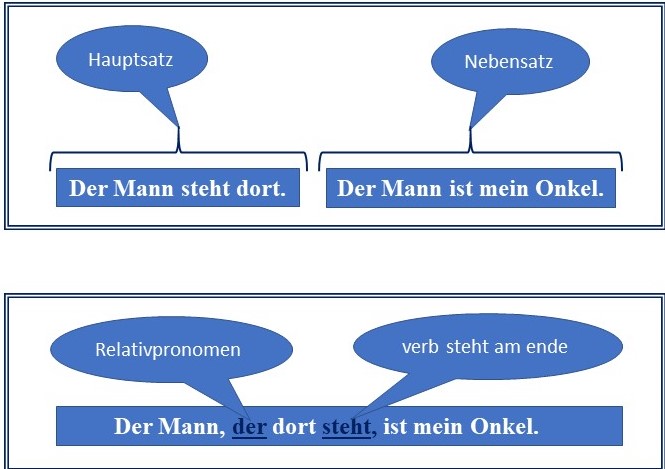Relativsatz in Nominativ
(Relative sentences in Nominative)
Relativsatz in Nominativ
(Relative sentences in Nominative)
Today, we will study about Relative sentences. First of all we will understand the meaning of a relative sentence. We have 2 sentences, Main sentence and an auxiliary sentence. The auxiliary sentence gives more information about the main sentence. Each of them has a common noun. So, the noun of the auxiliary sentence can be replaced by a relative pronoun, thus forming a Relativsatz. We will see an example in English:
My brother likes bikes. My brother purchased Harley-Davidson.
My brother, who likes bikes, purchased Harley-Davidson.
Here, My brother is a noun which is common in both the sentences. The first sentence is the main sentence, whereas the second sentence is the auxiliary sentence. The auxiliary sentence is giving more information about the main sentence.
In German, the formation of Relativsatz is almost same, we just have to consider the gender and case before forming a sentence. We should also keep in mind the conjugation of verb. Mostly the definite articles are used as a relative pronoun . So the Relativsatz usually follow the declension pattern of definite articles. Let’s revise them:

In this lesson, we will discuss about the Relativsatz in Nominative case.
When two sentences are used. One is the Hauptsatz (Main sentence), the other one is the Nebensatz/ Relativsatz (Subordinate sentence).

Masculine:
We will understand with the help of examples:
- Der Mann steht dort. Der Mann ist mein Onkel.
We see 2 sentences. The first one is Hauptsatz and the second one is Relativsatz. The noun “der Mann” is common in both the sentences. Now when we will form the Relativsatz, “der Mann” will be replaced by the nominative article “der” and the verb will go at the end and will be conjugated. Relativ pronouns is usually placed after the noun we are talking about. z.B. hier we are talking about „der Mann“, so relative pronounn will come after “der Mann”.
Der Mann, der dort steht, ist mein Onkel.
2. Mein Bruder hat eigene Wohnung. Mein Bruder wohnt in Paris.
Mein Bruder, der in Paris wohnt, hat eigene Wohnung.
3. Herr Müller ist Arzt. Er kommt heute.
Herr Müller, der heute kommt, ist Arzt
4. Der Rucksack ist kaputt. Der Rucksack ist klein.
Der Rucksack, der klein ist, ist kaputt.
In these sentence also we notice that the relative pronoun is “der” and verb is at the end.
Feminine
- Die Frau ist meine Tante. Sie kocht dort.
Die Frau , die dort kocht , ist meine Tante
2. Die Frau ist meine Mutter. Die Frau hat gelbe Jacke.
Die Frau, die gelbe Jacke hat, ist meine Mutter.
3. Meine Schwester schläft viel. Sie ist heute früh wach.
Meine Schwester, die viel schläft, ist heute früh wach.
4. Die Tasche ist ein Geschenk. Die Tasche liegt auf dem Tisch.
Die Tasche , die auf dem Tisch liegt , ist ein Geschenk.
Neutrum
- Ich wohne in einem Haus. Mein Haus liegt den Park gegenüber.
Ich wohne in einem Haus, das dem Park gegenüber liegt.
2. Hast du das Heft? Ich habe das gestern gekauft.
Hast du das Heft, das ich gestern gekauft habe.
3. Das Kind ist mein Neffe. Das Kind spielt dort.
Das Kind, das dort spielt , ist mein Neffe.
4. Du trafst gestern das Mädchen. Es ist meine Tochter.
Das Mädchen, das du gestern trafst, ist meine Tochter.
Plural
- Die Kinder sind aus Berlin. Die Kinder spielen dort.
Die Kinder, die dort spielen, sind aus Berlin.
2. Ich kenne einige Leute. Die Leute sind Fahrer vom Beruf.
Ich kenne einige Leute, die Fahrer vom Beruf sind.
3. Sie haben viele Freunde. Die Freunde besuchen ihr gern.
Sie haben viele Freunde, die ihr gern besuchen.
4. Die Augen sind groβ. Die Augen sind schön.
Die Augen, die groß sind, sind schön.



